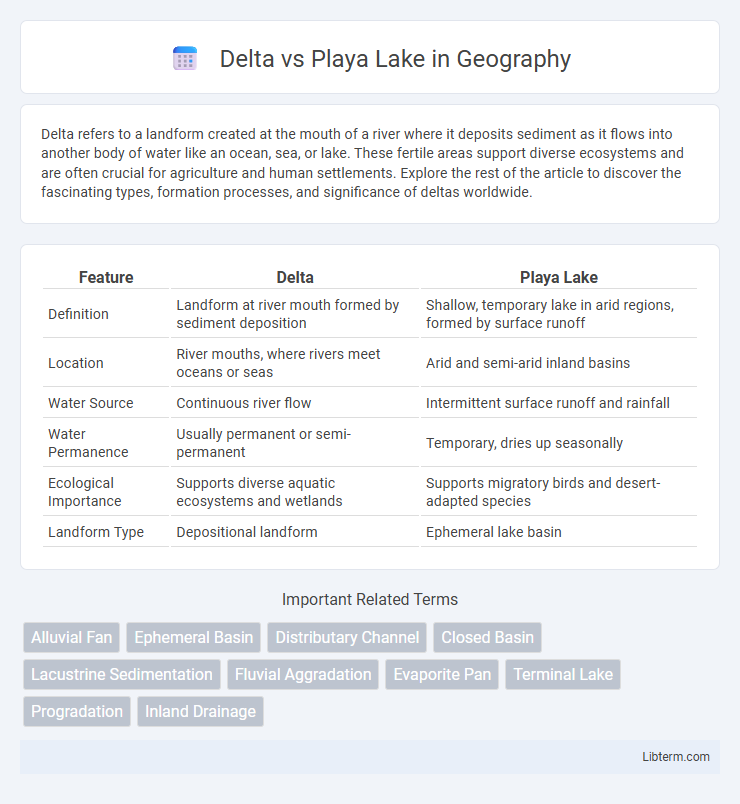Delta refers to a landform created at the mouth of a river where it deposits sediment as it flows into another body of water like an ocean, sea, or lake. These fertile areas support diverse ecosystems and are often crucial for agriculture and human settlements. Explore the rest of the article to discover the fascinating types, formation processes, and significance of deltas worldwide.
Table of Comparison
| Feature | Delta | Playa Lake |
|---|---|---|
| Definition | Landform at river mouth formed by sediment deposition | Shallow, temporary lake in arid regions, formed by surface runoff |
| Location | River mouths, where rivers meet oceans or seas | Arid and semi-arid inland basins |
| Water Source | Continuous river flow | Intermittent surface runoff and rainfall |
| Water Permanence | Usually permanent or semi-permanent | Temporary, dries up seasonally |
| Ecological Importance | Supports diverse aquatic ecosystems and wetlands | Supports migratory birds and desert-adapted species |
| Landform Type | Depositional landform | Ephemeral lake basin |
Introduction to Delta and Playa Lake
Deltas form where rivers deposit sediment as they flow into slower-moving or standing bodies of water, creating landforms characterized by distributary channels and fertile soil. Playa lakes are shallow, temporary basins in arid regions that fill with water seasonally from rainfall or runoff but typically dry out quickly, leaving behind evaporite minerals. Both features significantly influence local ecosystems but differ in formation processes, water permanence, and sediment deposition patterns.
Formation Processes of Deltas
Deltas form where rivers deposit sediment as they enter slower-moving or standing water bodies, such as lakes or oceans, causing sediment accumulation at the river mouth. In contrast, playa lakes are shallow, ephemeral basins primarily shaped by evaporative processes in arid regions, with minimal sediment deposition from river inflow. The key formation difference lies in deltas being products of continuous fluvial sedimentation and distributary channel evolution, while playa lakes result from intermittent flooding and evaporation cycles.
Formation Processes of Playa Lakes
Playa lakes form through the accumulation of water in arid or semi-arid regions, typically within closed basins where runoff from surrounding highlands collects and evaporates rapidly. Unlike deltas, which develop at river mouths where sediment-laden water disperses into standing bodies of water, playa lakes result from surface runoff and intermittent flooding that concentrate sediments in low-lying areas. The cyclical evaporation in playa lakes leads to the deposition of evaporites and fine-grained sediments, distinguishing their formation from the depositional processes of deltaic environments.
Geographic Distribution: Deltas vs Playa Lakes
Deltas primarily form at the mouths of rivers where sediment is deposited into larger bodies of water, creating fertile, triangular landforms typically found in coastal regions like the Nile Delta or the Mississippi Delta. Playa lakes are shallow, temporary bodies of water located in arid or semi-arid basins, commonly found in desert environments such as the southwestern United States or parts of northern Africa. These contrasting geographic distributions highlight how deltas thrive in humid, sediment-rich environments, while playa lakes occur in interior, dry basins with limited water input.
Hydrological Characteristics
Delta lakes exhibit high sediment deposition due to river inflow carrying suspended particles, creating shallow water bodies with variable salinity levels. Playa lakes are ephemeral, typically found in arid regions, characterized by closed basins with high evaporation rates leading to fluctuating water volumes and increased salinity concentration. Hydrological dynamics of delta lakes rely heavily on river discharge and sediment load, while playa lakes depend on precipitation and groundwater inputs with minimal outflow, resulting in distinct water balance regimes.
Sediment Deposition and Soil Composition
Deltas form where rivers deposit sediments rapidly as they enter standing water bodies, resulting in layered, fertile alluvial soils rich in silts and clays. Playa lakes, in contrast, accumulate fine sediments through periodic flooding and evaporation, often creating saline or alkaline soils with high concentrations of evaporite minerals. The distinct sediment deposition patterns in deltas support diverse, nutrient-rich ecosystems, while playa lake soils tend to be less fertile and more variable due to their intermittent water presence.
Ecological Significance and Biodiversity
Deltas serve as critical ecological hubs where nutrient-rich sediments support diverse plant and animal communities, fostering high biodiversity in aquatic and terrestrial ecosystems. Playa lakes, though intermittent, provide vital habitats for migratory birds and specialized species adapted to fluctuating water availability, contributing to regional ecological balance. The distinct hydrological dynamics of deltas and playa lakes influence their roles in sustaining biodiversity and ecosystem services in arid and coastal environments.
Human Interactions and Impacts
Deltas experience intensive human interactions through agriculture, urban development, and industrial activities that often lead to habitat loss, pollution, and altered water flow. Playa lakes, typically located in arid regions, face impacts from groundwater extraction, livestock grazing, and land conversion, which can reduce water availability and degrade wetland ecosystems. Both environments are critical for biodiversity but require sustainable management to mitigate human-induced changes and preserve their ecological functions.
Environmental Challenges and Conservation
Delta ecosystems face significant environmental challenges, including water pollution and habitat loss due to agricultural runoff and urban expansion. Playa lakes, characterized by intermittent water presence in arid regions, are threatened by groundwater depletion and climate change-induced variability in precipitation. Conservation efforts prioritize sustainable water management and habitat restoration to maintain biodiversity and ecological balance in both delta and playa lake environments.
Key Differences: Delta vs Playa Lake
Deltas form at river mouths where sediment deposits create landforms influenced by continuous water flow, resulting in fertile soils and diverse ecosystems. Playa lakes are shallow, temporary water bodies in arid regions, characterized by evaporation and sediment accumulation without continuous inflow or outflow. Key differences include deltas being permanent, sediment-rich structures shaped by fluvial processes, while playa lakes are ephemeral, often salt-encrusted basins dependent on precipitation and evaporation cycles.
Delta Infographic

 libterm.com
libterm.com